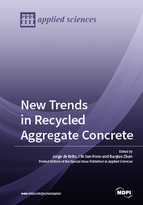New Trends in Recycled Aggregate Concrete
A special issue of Applied Sciences (ISSN 2076-3417). This special issue belongs to the section "Materials Science and Engineering".
Deadline for manuscript submissions: closed (30 September 2018) | Viewed by 67884
Special Issue Editors
Interests: CIB—International Council for Research and Innovation in Building and Construction; durability of building elements, maintenance of buildings; rehabilitation of buildings; building life cycle assessment
Special Issues, Collections and Topics in MDPI journals
Interests: eco-friendly construction materials; waste recycling and management; high performance concrete
Special Issue Information
Dear Colleagues,
Concrete is the most used manufactured material in the world and certainly one of most impacting ones on the environment. However, there is no envisaged alternative to this material within a developing world context. Therefore, there is a pressing need to promote the reduction of the environmental impacts of concrete, guaranteeing, at the same time, that its technological and economic advantages remain valid.
One of the ways to achieve this objective is by replacing part or all of the natural aggregates with alternatives resulting from recycled materials or various types of waste/by-products from several industries, including construction. Many of the consequences on the technical, economic and environmental performance of recycled aggregate concrete have been established by the very dynamic research on this subject. Nevertheless, there is both a lag between research and industry practical applications and a number of subjects that still need to be explored, which represent new trends in the search for sustainable recycled aggregate concrete.
This Special Issue is therefore dedicated to “New Trends in Recycled Aggregate Concrete” and it intends to welcome contributions on, but not limited to, the following subjects:
- Upscaling the use of recycled aggregate concrete in structural design;
- Large scale applications of recycled aggregate concrete;
- Long-term behaviour of recycled aggregate concrete;
- Performance of recycled aggregate concrete in very aggressive environments;
- Reliability of recycled aggregate concrete structures;
- Life cycle assessment of recycled aggregate concrete;
- Mesostructure analysis of recycled aggregate concrete.
Prof. Dr. Jorge de Brito
Prof. Dr. Chi Sun Poon
Dr. Baojian Zhan
Guest Editors
Manuscript Submission Information
Manuscripts should be submitted online at www.mdpi.com by registering and logging in to this website. Once you are registered, click here to go to the submission form. Manuscripts can be submitted until the deadline. All submissions that pass pre-check are peer-reviewed. Accepted papers will be published continuously in the journal (as soon as accepted) and will be listed together on the special issue website. Research articles, review articles as well as short communications are invited. For planned papers, a title and short abstract (about 100 words) can be sent to the Editorial Office for announcement on this website.
Submitted manuscripts should not have been published previously, nor be under consideration for publication elsewhere (except conference proceedings papers). All manuscripts are thoroughly refereed through a single-blind peer-review process. A guide for authors and other relevant information for submission of manuscripts is available on the Instructions for Authors page. Applied Sciences is an international peer-reviewed open access semimonthly journal published by MDPI.
Please visit the Instructions for Authors page before submitting a manuscript. The Article Processing Charge (APC) for publication in this open access journal is 2400 CHF (Swiss Francs). Submitted papers should be well formatted and use good English. Authors may use MDPI's English editing service prior to publication or during author revisions.
Keywords
- recycled aggregates
- mix design
- structural concrete design
- environmental performance
- upscaling








